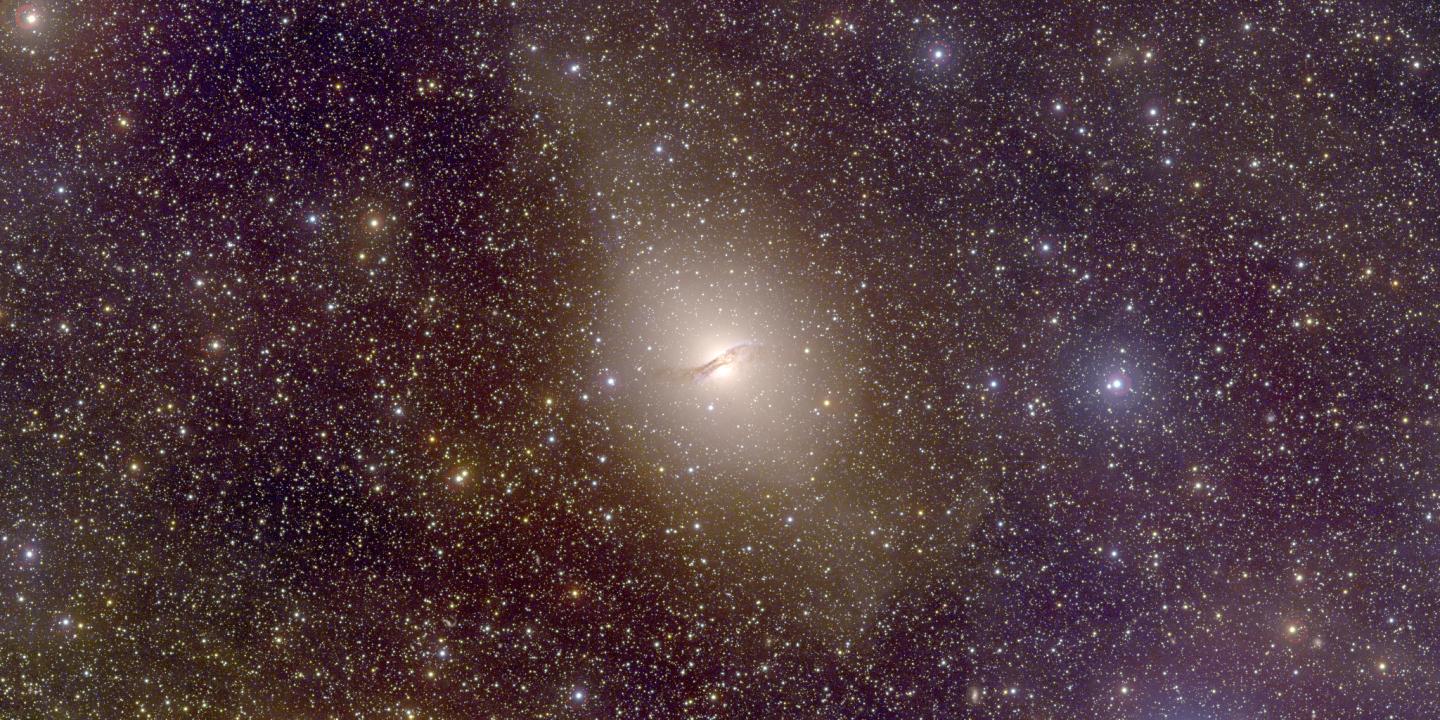Galaxies Rotate in Sync, Raising Dark Matter Questions
The universe is filled with galaxies, and often a large galaxy like our own will have several smaller ones orbiting it. Astronomers looked at one particular group of galaxies and noticed their circling was a bit too orderly for current models to explain.
Most scientists' understanding of our universe includes a substance called dark matter, which accounts for 80 percent of the matter in the universe. Dark matter was first hypothesized in order to account for the rotation of galaxies, which didn't seem to have enough conventional matter to keep them from flying apart like a smoothie in a lidless blender. Dark matter provides the extra stuff needed to keep galaxies together and was likely involved in galaxy formation. Dark matter appears to be cobwebbed across the universe. Scientist suspect that dwarf galaxies form along these dark matter threads and converge where they meet, merging into larger galaxies.
Under this framework, satellite galaxies should be distributed randomly around their host, following elongated orbits in arbitrary directions. This assumption was challenged when scientists found that satellites of our own Milky Way and the Andromeda galaxy, our closest major neighbor, don't follow this prediction. The small companion galaxies appear to rotate in sync with each other, following fairly circular paths in a disk-shaped plane around their host galaxy. [Gallery: 65 All-Time Great Galaxy Hits]

"These two distributions could not be more different," Stacy McGaugh, an expert in cosmologic modeling at Case Western Reserve University in Ohio, told Space.com.
Now scientists have found a third example of a highly ordered satellite system. In 2015, group of astronomers found that most of the dwarf galaxies orbiting the large galaxyCentaurus A did so in a plane perpendicular to the galaxy's disk. After hearing of this, a team of astronomers led by the University of Basel looked at the individual satellite galaxies circling Centaurus A, which is the richest assembly of galaxies within 30 million light-years of the Milky Way, according to the study. By tracking the positions and velocities of the satellites, the team discovered that 14 of the 16 companions orbit Centaurus A in the same direction. The latest findings were detailed Feb. 1 in the journal Science.
"A statistical outlier will happen once or twice," the University of Basel's Oliver Müller, lead author on the new work, told Space.com. "So we would expect that we find stuff by pure chance such as this. But if we find three of those systems close to each other, and every galaxy group has a .1 percent chance to exist [in such a well-ordered state] … then what is the probability of that?"
McGaugh, who was not involved with the study, agrees that the observation is a cause for concern for the current model. "It's not just a quibble," he said. "It's the third of three, [and] we haven't seen one that behaves right."
Get the Space.com Newsletter
Breaking space news, the latest updates on rocket launches, skywatching events and more!
When it comes to satellite galaxies, "you can drop them in from afar or spin them out," McGaugh said. One way to produce these organized systems in the current model is to assume that the dwarf galaxies all formed elsewhere in space and fell into orbit around the host galaxy at the same time. This is, however, unlikely, McGaugh said.
Alternatively, they might have formed more recently, from interactions between nearby galaxies tugging on each other like the moon tugs on the Earth, raising the ocean to create tides. If this were the case, material might swirl off a galaxy, coalesce into a dwarf galaxy and begin to orbit its host. These tidal dwarf galaxies would naturally orbit in the plane of interaction between the two larger galaxies, and would likely circle in the same direction, Müller said.
Unfortunately, such a scenario is highly unlikely in the prevailing model, McGaugh said. It is likely under a competing model of the universe, but this rival has other drawbacks. "Sometimes, the best current answer is, 'We don't know,'" McGaugh said.
Müller hopes the observations from Centaurus A broaden the conversation about proposals like this one. "It would be really cool to see all the different explanations of such structures, how they can be formed," he said.
Follow Harrison @harrisontasoff. Follow us @Spacedotcom, Facebook and Google+. Original article on Space.com.
Join our Space Forums to keep talking space on the latest missions, night sky and more! And if you have a news tip, correction or comment, let us know at: community@space.com.

Harrison Tasoff is a science journalist originally from Los Angeles. He graduated from NYU’s Science, Health, and Environmental Reporting Program after earning his B.A. in mathematics at Swarthmore College. Harrison covers an array of subjects, but often finds himself drawn to physics, ecology, and earth science stories. In his spare time, he enjoys tidepooling, mineral collecting, and tending native plants.









